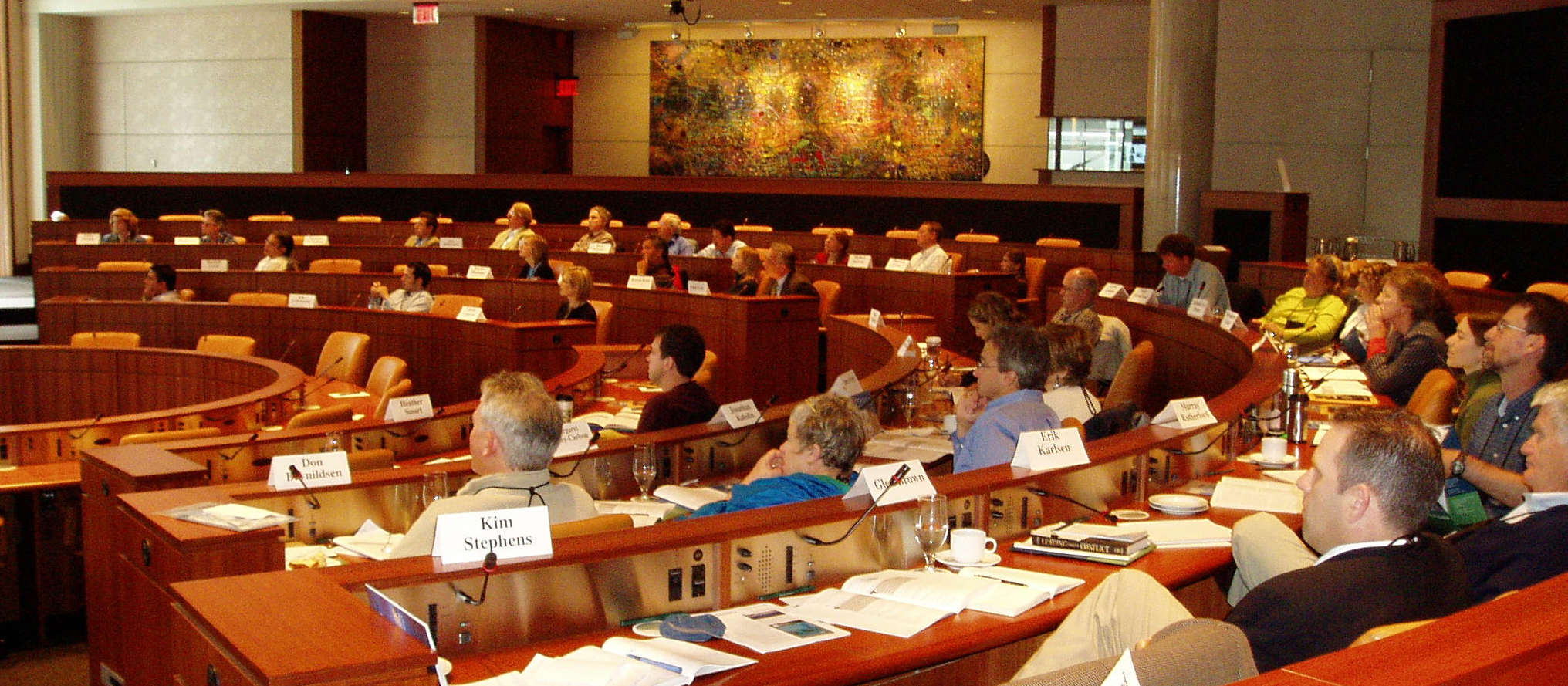Water and Cities: Acting on the Vision
Dialogue event designed to identify workable solutions that will be useful in guiding water resource decisions
In June 2006, Water and Cities: Acting on the Vision immediately preceded the Third World Urban Forum in Vancouver. Given that by 2030, 60% of the world’s population will be living in urban area, the following question provided an over-arching framework for dialogue: How will an urban water crisis be solved – particularly since many cities today, especially in low income nations, are not 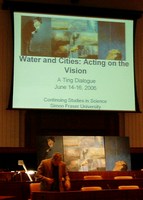 connected to sources of water supply or sanitation?
connected to sources of water supply or sanitation?
This dialogue-based event was held at the Wosk Centre for Dialogue, and provided an opportunity to map out practical strategies and solutions to address ‘water issues’ of concern and act on the vision of ‘sustainable and equitable’ water resource management for cities, globally. The program design included field trips, case study presentations, expert panel discussions and dialogue focused on key issues, solutions and actions.
According to Patricia Gallaugher, Chair of the Steering/Advisory Committee, “Experience shows that big meetings don’t work in terms of creating change. The program design for Water and Cities is predicated on the realization that moving  from talk to action starts with people having a conversation. Spontaneous communication in turn leads to dialogue; and it is dialogue that leads to consensus on what needs to be done. This is the reason for holding the event at the Wosk Centre for Dialogue. When we look back years from now, our hope is that Water and Cities will be seen to have been a measurable step forward in an education-based process that has made a difference in the way cities manage water.”
from talk to action starts with people having a conversation. Spontaneous communication in turn leads to dialogue; and it is dialogue that leads to consensus on what needs to be done. This is the reason for holding the event at the Wosk Centre for Dialogue. When we look back years from now, our hope is that Water and Cities will be seen to have been a measurable step forward in an education-based process that has made a difference in the way cities manage water.”
To Learn More:
To download the event proceedings, click on Proceedings from Water & Cities: Acting on the Vision
Building on the Success of Previous Dialogue Events
Organized by Continuing Studies in Science and the Centre for Coastal Studies at Simon Fraser University (SFU), the three-day Water and Cities was a highly interactive and focused dialogue among a limited number of invited participants who represented international freshwater experts, government managers and policy makers, industry, NGOs and communities. Invitees came from across Canada, the United States, New Zealand, South Africca, Costa Rica and Nepal.
This international multi-sectoral event built on a former successful dialogue and think tank, Water and the Future of Life on Earth, hosted by SFU and the University of British Columbia at the Wosk Centre for Dialogue in May 2002 and the 2005 landmark dialogue on oceans and coastal sustainability, Changing Currents: Charting a Course of Action for the Future of Oceans.
Program Design
Throughout the three days, dialogue was guided by a number of questions that addressed the perspectives of different sectors. According to Glenn Sigurdson, 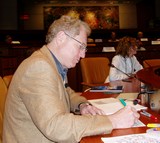 Dialogue Fellow at the Wosk Centre, who facilitated thew workshop, “The program also took into account the fact that not all cities are dealing with the same problems – and solutions will vary according to availability of funding and biogeographical region (eg coastal, mountain, desert, prone to flooding) in addition to predicted impacts of climate change.” On Days Two and Three, the program comprised sessions on these six topics:
Dialogue Fellow at the Wosk Centre, who facilitated thew workshop, “The program also took into account the fact that not all cities are dealing with the same problems – and solutions will vary according to availability of funding and biogeographical region (eg coastal, mountain, desert, prone to flooding) in addition to predicted impacts of climate change.” On Days Two and Three, the program comprised sessions on these six topics:
1. Water Conservation
2. Water Supply Protection
3. Infrastructure Renewal
4. Small Systems
5. Changing Human Behaviour
6. Education and Training
“The format comprised case study presentations followed by a Dialogue Circle and a Dialogue Synthesis. Designated responders were asked to convene in the Dialogue Circle and comment on the case studies”, added Sigurdson, “A set of defining questions provided context for their responses. These responses were then synthesized into a set of ‘this is what I heard’ observations by a designated observer.”
“The outcome of this analysis will be a practical document describing the case studies and responses to the questions, and summarizing the analysis, synthesis and recommendations”, concluded Patricia Gallaugher, “We anticipate that this document will provide workable solutions that will be useful in guiding fresh water resource managers and policy makers at all levels of government and communities. It will be available in print and electronically on the SFU web site.”
Participation of the Water Sustainability Committee
The Water Sustainability Committee of the BCWWA (British Columbia Water & Waste Association) made a significant contribution to the success of the event, with three representatives playing roles in Dialogue Circles:
- Kim Stephenswas one of five designated Responders in the Dialogue Circle for Water Conservation and also facilitated a group discussion in a Dialogue Cluster.
 Erik Karlsen provided the Plenary Report Back and Synthesis for the Water Conservation Dialogue; and together with the other synthesizers, participated in the final Dialogue Circle which provided the overarching Synthesis and Wrap Up.
Erik Karlsen provided the Plenary Report Back and Synthesis for the Water Conservation Dialogue; and together with the other synthesizers, participated in the final Dialogue Circle which provided the overarching Synthesis and Wrap Up.- Glen Brown was one of two designated Responders in the Dialogue Circle for Infrastructure Renewal.
This participation provided the opportunity to context what is being accomplished under the umbrella of the Water Sustainability Action Plan for British Columbia when addressing questions that framed each dialogue session.
Water Conservation
Case studies by Deborah Walker (Capital Regional District, Victoria, BC) and Jonathan Kaledin (The Nature Conservancy, Albany, New York) set the scene for a Dialogue Circle comprising:
- Michael Jackson, Culex Environmental Ltd
- Jenyfer Neumann, Township of Langley
- Michele-Lee Moore, BC Ministry of Environment
- Kim Stephens, Water Sustainability Action Plan for BC
- Bruce Wilson, Water Supply Association of BC
Dialogue Cluster:
A set of four questions provided a framework for both the Dialogue Circle and Dialogue Cluster:
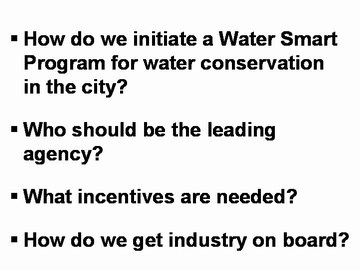
“Water and Cities enabled us to introduce our water balance way-of-thinking, and in particular our Water OUT = Water IN approach, to an international audience”, commented Kim Stephens, Program Coordinator for the Water Sustainability Action Plan,
“In fact, the OUT = IN equation proved quite helpful in stimulating discussion in the breakout group that I facilitated. It was interesting to see how quickly people picked  up on the concept and the conversation really got rolling. Very quickly a number of key messages emerged as people clued in to the implications of an equation that is variable on both sides, and they saw the potential for changing the variables.” In reporting back at the plenary part of the session, Stephens summarized the key messages from the group discussion as follows:
up on the concept and the conversation really got rolling. Very quickly a number of key messages emerged as people clued in to the implications of an equation that is variable on both sides, and they saw the potential for changing the variables.” In reporting back at the plenary part of the session, Stephens summarized the key messages from the group discussion as follows:
- Everything is connected, and we are talking about more than just water conservation. At the end of the day, it really is about water cycle management and the closed loop way-of-thinking.
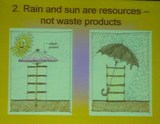 The simplicity and credibility of the messaging will carry the day, which is why Water OUT = Water INis so powerful in communicating complexity in way that is easy to understand.
The simplicity and credibility of the messaging will carry the day, which is why Water OUT = Water INis so powerful in communicating complexity in way that is easy to understand.- Just do it! must be our mantra, so that we can be learn by doing; otherwise we have ‘paralysis by analysis’.
- Change starts with a one-on-one conversation, because people are energized by the ‘human connection’, especially when an incentive can be provided so that they will indeed ‘walk the talk’.
Infrastructure Renewal
 Building on the theme of how to motivate change on-the-ground, later in the program Glen Brown, BC Ministry of Community Services, explained how federal/provincial infrastructure programs are now being linked to regional growth strategies as a means of providing an incentive for local governments to change the way they do business.
Building on the theme of how to motivate change on-the-ground, later in the program Glen Brown, BC Ministry of Community Services, explained how federal/provincial infrastructure programs are now being linked to regional growth strategies as a means of providing an incentive for local governments to change the way they do business.
“There is a strong linkage between effective long-term local government planning and long-term infrastructure costs. In the case of water-centric infrastructure, the Ministry of Community Services supports innovative local government planning and is working proactively to improve the integration of long-term, strategic planning and the implementation of physical infrastructure”, stated Brown, “The Ministry foresees future grant programs may have requirements built into them that ensure that strategic and sustainable planning is integral to a successful application.”
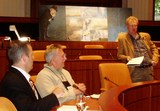 Brown and Don Brynildsen (City of Vancouver) were in the Dialogue Circle case study following presentations by Steve Moddemeyer (City of Seattle) and Michael D’Andrea (City of Toronto). Two questions provided the frame-of-reference for this session: What are innovative approaches for infrastructure renewal? What are cost-effective renewal programs?
Brown and Don Brynildsen (City of Vancouver) were in the Dialogue Circle case study following presentations by Steve Moddemeyer (City of Seattle) and Michael D’Andrea (City of Toronto). Two questions provided the frame-of-reference for this session: What are innovative approaches for infrastructure renewal? What are cost-effective renewal programs?
Rainwater / Stormwater Management
The case studies in the session on Stormwater Management were effectively an extension of what falls under the umbrella of the Water Sustainability Action Plan, in part because the two presenters represented agencies that are partners in the Water Balance Model for British Columbia. Richard Boase of the District of North Vancouver and Lance Jacubec of Canada Mortgage & Housing Corporation were asked to address these questions in their presentations:
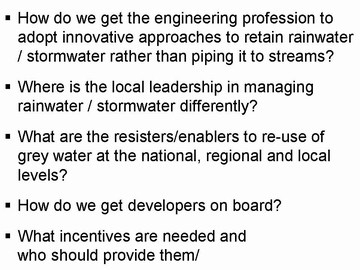
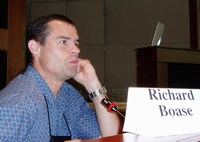 Richard Boase addressed the first two questions in his presentation titled Rainwater Management on Single Family Properties – Water Balance for Watershed Health. A key message to emerge from the resulting dialogue is that “n British Columbia, it is the engineering profession that is in fact making new approaches happen.In retrospect, the watershed year for change in British Columbia was 2002. That was the tipping point because Stormwater Planning: A Guidebook for British Columbia was published, the Chilliwack Surface Management Manual was adopted by City Council, the Burnaby Mountain and East Clayton (City of Surrey) projects proceeded to implementation, and the Water Balance Model was launched.
Richard Boase addressed the first two questions in his presentation titled Rainwater Management on Single Family Properties – Water Balance for Watershed Health. A key message to emerge from the resulting dialogue is that “n British Columbia, it is the engineering profession that is in fact making new approaches happen.In retrospect, the watershed year for change in British Columbia was 2002. That was the tipping point because Stormwater Planning: A Guidebook for British Columbia was published, the Chilliwack Surface Management Manual was adopted by City Council, the Burnaby Mountain and East Clayton (City of Surrey) projects proceeded to implementation, and the Water Balance Model was launched.
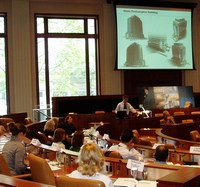 Lance Jacubec addressed the last three questions with a presentation titled Enabling Residential Water Reuse. The goal of CMHC is to assess the performance of alternate technical approaches and identify barriers to the adoption and use of those approaches. Lance reviewed information from a number of research projects across Canada. He quoted from a 1997 report that concluded “…the most significant barrier to implementation of onsite water reuse may be the lack of regulations and guidance across the country.”
Lance Jacubec addressed the last three questions with a presentation titled Enabling Residential Water Reuse. The goal of CMHC is to assess the performance of alternate technical approaches and identify barriers to the adoption and use of those approaches. Lance reviewed information from a number of research projects across Canada. He quoted from a 1997 report that concluded “…the most significant barrier to implementation of onsite water reuse may be the lack of regulations and guidance across the country.”
Julia Brydon of Environment Canada was one of two responders in the Dialogue Circle that followed the case study presentations. The Inter-Governmental Partnership that developed the Water Balance Model is co-chaired by Environment Canada. Julia is a member of the Steering Committee that is overseeing the ongoing enhancement of this scenario modeling and decision support tool.



